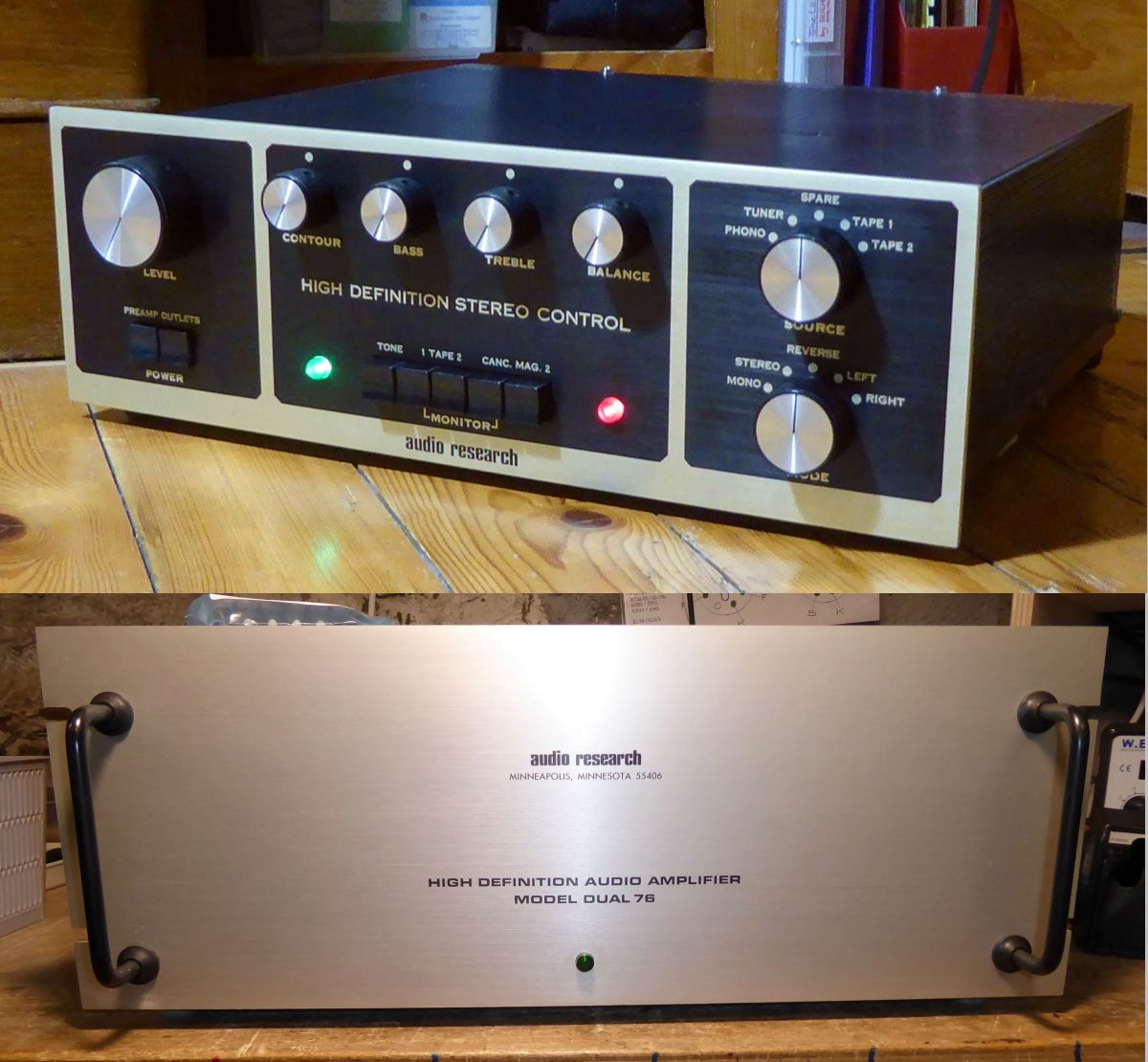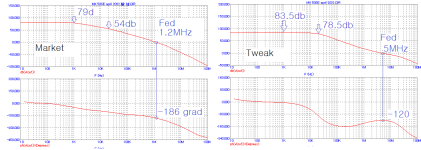A high damping factor is required for dynamic heads with a light suspension and a large mass of the moving system, operating close to the area of the main mechanical resonance. Simply put, a low-frequency speaker without a crossover filter.From a sound standpoint, this amp appears to have an iron grip on the speaker, as it's bass is very extended, fast, tight and controlled.
When loading an amplifier onto a woofer with a passive crossover, the system's damping factor is determined mainly by the output impedance of the crossover in its passband, so the requirements for the amplifier's dumping factor can be reduced.
Hennady, so if I understand you correctly, amplifiers with high dampening factors will exhibit less sonic impact on the speaker they are connected to. Conversely, those with low dampening require care in speaker matching to have less interaction with it's crossover.
I'm still wondering what in the design causes this amp to have high output impedance, and does high output impedance also a cause a low dampening factor?
I'm still wondering what in the design causes this amp to have high output impedance, and does high output impedance also a cause a low dampening factor?
Last edited:
If you are not involved in sounding stadiums for rock concerts and at home you have a regular speaker system with crossovers, then it is not necessary to know the value of DF. At home, an amplifier with DF=1000 and DF=200 will work the same for hearing.Hennady, so if I understand you correctly, amplifiers with high dampening factors will to exhibit less sonic impact on the speaker they are connected to. Conversely, those with low dampening require care in speaker matching to have less interaction with it's crossover.
the final output impedance of the amplifier is equal to the output impedance of the open loop output stage without common negative feedback divided by the value of the feedback depth, i.e. only local feedback of the output transistors, so by ear the output stage with Shiklai is preferable.I'm still wondering what in the design causes this amp to have high output impedance, and does high output impedance also a cause a low dampening factor?
Interesting you mention tube amps, as ARC in their literature does attribute the sound of this design to that of a tube amp. https://www.arcdb.ws/model/100.2It may be possible to measure it with a couple of resistors, say two 10 ohm resistors, set it on one 10ohm to 1Vpp at say 1kHz and then parallel in the second 10 ohm and see when the voltage drops too.
Then with a small amount of magic maths if should be possible to get the number.
(note: I've not worked out the maths, but it's ohms law and solving for an unknown 😀 )
I think some speakers require more current than others, but I also doubt that any tube amp comes close to s solid state one.
A high damping factor is required for dynamic heads with a light suspension and a large mass of the moving system, operating close to the area of the main mechanical resonance. Simply put, a low-frequency speaker without a crossover filter.
When loading an amplifier onto a woofer with a passive crossover, the system's damping factor is determined mainly by the output impedance of the crossover in its passband, so the requirements for the amplifier's dumping factor can be reduced.
The voice coil resistance is always more or less in series with the amplifier output impedance, with or without crossover. However, the loudspeaker designers can take the crossover impedance and voice coil impedance into account, but not the amplifier's impedance, unless it is known to them.
I did a rough estimate of the output impedance by dividing 15K (R45) by the current gain of the EF2 (about 10^4), and then dividing by two for 6dB of negative feedback. This gives 0.8 ohms.I'm still wondering what in the design causes this amp to have high output impedance, and does high output impedance also a cause a low dampening factor?
There is also small-signal impedance of the BJTs and the 0.2 ohm emitter resistors that I am ignoring.
Typical solid-state amplifiers use much more negative feedback (20-60dB), and so the open-loop output impedance is divided by a factor of 10-1000.
The main effect of non-zero output impedance is to modulate the frequency response according to the speaker's impedance. Every speaker will sound different. Typically, the overlap between the drivers is increased. This may sound subjectively "better" depending on the speaker.
A long time ago on a different board, a group of members swore that Magnepans sounded better with tube amplification. I showed that the effect was due to output impedance and replicated it on my solid-state amplifier by adding a series resistor.
Ed
In general case, adding resistance does not increase the output impedance of the amplifier. The resistor value is added to the cable resistance value Rdx when matching the voltage between the amplifier and the speaker system. With a large DF value and low output power, when listening, only the spectral composition at the speaker terminals will change, which is perceived as the sound of a tube amplifier due to the presence of an output transformer.A long time ago on a different board, a group of members swore that Magnepans sounded better with tube amplification. I showed that the effect was due to output impedance and replicated it on my solid-state amplifier by adding a series resistor.
Ed
The damping factor is frequency dependent due to both the open-loop gain dropping with frequency and the output inductor. Generally at the frequency of a woofer's resonance the limiting factor to damping for a GNFB amp is the speaker wire resistance and or passive cross over, not the amp.If you are not involved in sounding stadiums for rock concerts and at home you have a regular speaker system with crossovers, then it is not necessary to know the value of DF. At home, an amplifier with DF=1000 and DF=200 will work the same for hearing.
the final output impedance of the amplifier is equal to the output impedance of the open loop output stage without common negative feedback divided by the value of the feedback depth, i.e. only local feedback of the output transistors, so by ear the output stage with Shiklai is preferable.
This is true for amplifiers with miller correction, i.e. most vintage amps. With progressive correction, the linearity of which is high Open loop, so this statement of yours is not relevant.The damping factor is frequency dependent due to both the open-loop gain dropping with frequency and the output inductor.
see attachment on the left Miller correction, on the right progressive correction
Attachments
Last edited:
You have repeated my point exactly.In general case, adding resistance does not increase the output impedance of the amplifier. The resistor value is added to the cable resistance value Rdx when matching the voltage between the amplifier and the speaker system. With a large DF value and low output power, when listening, only the spectral composition at the speaker terminals will change, which is perceived as the sound of a tube amplifier due to the presence of an output transformer.
Ed
I found my post from 2002.
https://www.audioasylum.com/cgi/vt.mpl?f=mug&m=40834
The post remains but the thread history has been lost.
Ed
Maggies and tubes
209.86.1.59
Posted on December 7, 2002 at 09:22:02
EdG
Audiophile
Posts: 340
Location: California
Joined: June 10, 2001
Please read my article.
Much of the difference in sound between a solid-state amp and a tube amp is due to the latter's output impedance shifting the MG1.6's crossover points. The effect is to alter the speaker's voicing by filling in the midrange. Tubes sound better but not so much due to the tubes, but more the effects of the tube amp's output impedance on the MG1.6 crossover.
Different Magnepan models will respond to impedance differently, so you may not get the same results with your MMGs as your friend got with the MG1.6. Personally, I like the MG1.6.
Ed
https://www.audioasylum.com/cgi/vt.mpl?f=mug&m=40834
The post remains but the thread history has been lost.
Ed
ARC's claim to fame have always been their vacuum tube offerings.
Yes. That's why I still keep my ARC SP3A1 and D76 (1974) :

T
ARC puts more effort in voicing their amplifiers via critical listening than many other manufacturers it seems. Increasingly on this amp as opposed to their other immediate D series predecessors, ARC has settled on less feedback, higher bias, and a higher output impedance design, likely to obtain a more tube like sonic presentation. Again, from a sonic standpoint and even with a complex crossover load connected (LS3/5a for example), I am thoroughly impressed with the result. Though as many have stated, speaker interaction becomes much more relevant with these design criteria.
in fact, not all circuit structures of transistors can provide linearity in Open loop amplification, so cascade linearity is very often formed using local feedback and only then a General negative connection is introduced. If approximately the Damping Factor for speakers is sufficient DF = 20, this is the depth of the NFB = 24 dB, for a low-frequency woofer DF = 200 is sufficient, the depth of the NFB = 46 dB. Depending on the quality of the audio material and its compression ratio, the gain factor is selected, which, together with the feedback depth, gives the overall gain of the Open loop amplifier circuit.ARC has settled on less feedback,
low output impedance is necessary primarily for the linearity of the speaker system. For real reference acoustic systems, a high DF is not required.higher output impedance design
- Home
- Amplifiers
- Solid State
- Idiosycratic Amplifier Design Performance
